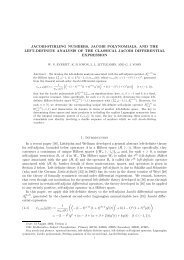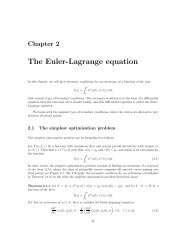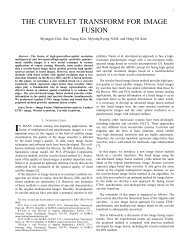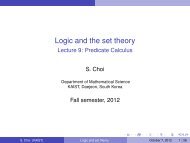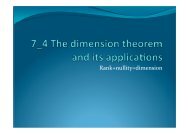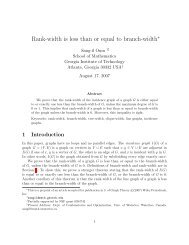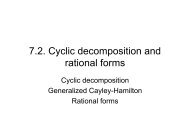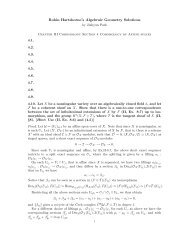On Random Discretization for Ito Diffusion Processes
On Random Discretization for Ito Diffusion Processes
On Random Discretization for Ito Diffusion Processes
Create successful ePaper yourself
Turn your PDF publications into a flip-book with our unique Google optimized e-Paper software.
3 Uni<strong>for</strong>mly Close Reconstruction of Brownian MotionFor numerical simulation of Brownian motion, we use normal random numberswith small variance, add them one by one on discretization points andinterpolate them linearly. But we don’t know what will happen actually oneach small time subinterval even though their probabilities are small. Here, wesuggest a new method <strong>for</strong> uni<strong>for</strong>mly close reconstruction of Brownian motion<strong>for</strong> which we need not worry about that small amount of probability. This isalso a motivation <strong>for</strong> section 2.We are concerned in the following simple processesdX t = adt + bdW t , X 0 = 0, (3)where a and b are constants. We call the process X t Brownian motion withdrift.For a small h > 0, let τ h be the first hitting time of W t to the levels y = h ory = −h and recursively we defineτ n := inf{t > τ n−1 : W t > W τn−1 + h or W t < W τn−1 − h}, (4)1 ≤ n ≤ N andN := sup{n : τ n < 1}, τ N+1 = 1.n≥1Hence we obtain a sequence of level crossing stopping times {τ n } 1≤n≤N+1 be<strong>for</strong>et = 1. <strong>On</strong> the random times {τ n } 1≤n≤N+1 , we apply the Euler schemeY τn+1 =n∧N ∑k=0a∆τ k +n∧N ∑k=0b∆W τk (5)and linearly interpolate the discrete points. This numerical process coincideswith X t on {τ n } 1≤n≤N+1 andsup |X t − Y t | < 2bh (6)t∈[0,1]i.e., Y t has a deterministic uni<strong>for</strong>m error bound by our construction. For thestopping times {τ n } 1≤n≤N+1 , N, the condition (2) becomesEe 2h2N < K<strong>for</strong> some K but we could not prove it because of the complicated densityfunction of τ. But still Y t converges to X t due to (6) when h ↓ 0. Note thatwhen W t fluctuates much, it crosses many levels and the discretization numberincreases and vice versa. Hence, our new method provides us a nice adaptivetime discretization <strong>for</strong> the process (3) while the adaptive schemes in [5] and6



